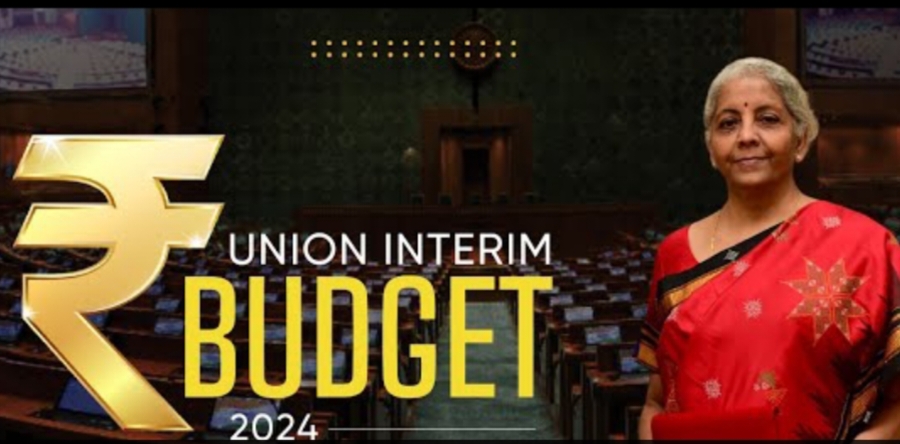
Watch: Union Interim Budget 2024 presented today in the Lok Sabha by Union Finance Minister Nirmala Sitharaman.
Access the budget speech text by clicking the link.
You may also like to read: Key to the budget documents 2024.
Highlights of the Union Interim Budget 2024
- India’s real GDP is projected to grow at 7.3 per cent in the financial year 2023-24.
- The Revised Estimate of the total receipts other than borrowings is ₹ 27.56 lakh crore, of which the tax receipts are ₹ 23.24 lakh crore. The Revised Estimate of the total expenditure is ₹ 44.90 lakh crore.
- Fiscal deficit in 2023-24 (re) to be 5.8 per cent of GDP; estimated to be 5.1 per cent of GDP in 2024-25.
- In 2024-25, the total receipts other than borrowings are estimated to be ₹ 30.80 lakh crore and the total expenditure is estimated at ₹ 47.66 lakh crore. The tax receipts are estimated at ₹ 26.02 lakh crore.
- Capital Expenditure is to be increased by 11.1 per cent to ₹ 11,11,111 crore; amounting to 3.4 per cent of the GDP.
- Total Expenditure in 2024-25 is to be increased by ₹ 2.76 lakh crore compared to 2023-24 (re); estimated at ₹ 47.66 lakh crore.
- Revenue receipts in 2023-24 at ₹ 30.03 lakh crore are expected to be higher than the Budget Estimate indicating growth momentum and formalization in the economy.
- Lower borrowings by the Central Government to facilitate more availability of credit for the private sector.
- The scheme of a fifty-year interest-free loan for capital expenditure to states will be continued this year with a total outlay of ₹1.3 lakh crore.
- A corpus of rupees one lakh crore will be established with a fifty-year interest-free loan for youth during 2024-25, gross and net market borrowings through dated securities are estimated at ₹ 14.13 lakh crore and ₹ 11.75 lakh crore respectively.
- The Foreign Direct Investment (FDI) inflow during 2014-23 was USD 596 billion, which is twice the inflow during 2005-14.
- For Railways, three major economic railway corridor programmes will be implemented-energy, mineral and cement corridors, port connectivity corridors, and high-traffic density corridors. Moreover, forty thousand normal rail bogies will be converted to the Vande Bharat standards to enhance the safety, convenience and comfort of passengers.
- The Finance Minister proposes a new corpus of rupees one lakh crore to boost private investment in sunrise technologies. The corpus will be established with a fifty-year interest-free loan. It will provide long-term financing or refinancing with long tenors and low or nil interest rates to encourage the private sector to scale up research and innovation.
Direct taxes
- FM proposes to retain the same tax rates for direct taxes
- Direct tax collection tripled, and return filers increased to 2.4 times, in the last 10 years
- Government to improve taxpayer services
- Outstanding direct tax demands up to Rs 25000 pertaining to the period up to FY 2009-10 withdrawn
- Outstanding direct tax demands up to Rs 10000 for financial years 2010-11 to 2014-15 withdrawn
- This will benefit one crore taxpayers
- Tax benefits to Start-Ups, investments made by Sovereign wealth funds or pension funds extended to 31.03.2025
- Tax exemption on certain income of IFSC units extended by a year to 31.03.2025 from 31.03.2024
Indirect taxes
- FM proposes to retain the same tax rates for indirect taxes and import duties
- GST unified the highly fragmented indirect tax regime in India
- Average monthly gross GST collection doubled to Rs 1.66 lakh crore this year
- The GST tax base has doubled
- State SGST revenue buoyancy (including compensation released to states) increased to 1.22 in the post-GST period(2017-18 to 2022-23) from 0.72 in the pre-GST period (2012-13 to 2015-16)
- 94% of industry leaders view the transition to GST as largely positive
- GST led to supply chain optimization
- GST reduced the compliance burden on trade and industry
- Lower logistics costs and taxes helped reduce the prices of goods and services, benefiting the consumers
– global bihari bureau





